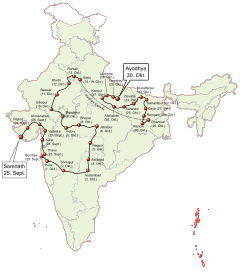Ram Rath Yatra

|
|
| Date | 25 September 1990 – 30 October 1990 |
|---|---|
| Location | Across the country |
| Outcome | Advani arrested |
The Ram Rath Yatra was a political-religious march from September to October 1990, organized by the Bharatiya Janata Party (BJP) and its Hindu-nationalist affiliates, and led by the then-BJP-president L. K. Advani. The purpose of the yatra was to support the agitation of the Vishwa Hindu Parishad and its Sangh Parivar affiliates to erect a temple to the Hindu deity Rama on the site of the Babri Masjid.
The Masjid, or mosque, had been built in the city of Ayodhya, considered holy by Hindus, following the Mughal conquest of the region in 1528. According to hearsay, it was built over a temple dedicated to Rama, and stood on the site of his birth. In the 1980s, the Vishwa Hindu Parishad and other Sangh Parivar affiliates began an agitation to build a temple to Rama at the site, with the Bharatiya Janata Party lending political support to the movement. In 1990, the government of India led by V. P. Singh decided to implement some of the recommendations of the Mandal commission, and announced that twenty-seven percent of government jobs would be reserved for people from lower-caste backgrounds. This announcement threatened the electoral constituency of the BJP, which decided to use the Ayodhya dispute to unite the Hindu vote by mobilizing anti-Muslim sentiments.
In order to further this movement, the BJP announced a rath yatra, or "chariot journey" across the country that would end in Ayodhya. The procession was led by L. K. Advani, and involved thousands of kar sevaks, or volunteers, from the Sangh Parivar. The yatra began in Somnath on 25 September 1990, and passed through hundreds of villages and cities. It traveled 300 kilometers a day, and Advani often addressed six public rallies in a single day. The yatra caused a huge outpouring of both religious and militant sentiments among Hindus, and became one of India's biggest mass movements.
...
Wikipedia
